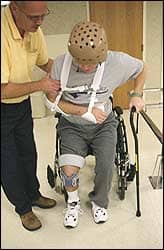Patients who’ve had a stroke and were rehabilitated using a robot to navigate virtual reality environments walked faster and a greater distance following physical therapy compared to those trained with the robot alone, according to researchers at the University of Medicine and Dentistry of New Jersey (UMDNJ)-School of Health Related Professions.
The study is believed to be the first to demonstrate improved walking ability in the laboratory and the community following rehabilitation with the robot/virtual reality system according to the researchers. "Effects of Training With a Robot-Virtual Reality System Compared With a Robot Alone on the Gait of Individuals After Stroke" details their results and will appear in the March print edition of Stroke. The article is available online now for journal subscribers.
"A robot alone only gives you a mechanism for doing the exercise. There is lots of repetition, which is a really big part of getting better, but the argument is you have to do the exercise for a purpose," says Judith E. Deutsch, PT, PhD, professor and director of the Research in Virtual Environments and Rehabilitation Sciences (RIVERS) Lab in the Department of Rehabilitation and Movement Science at the UMDNJ-School of Health Related Professions and a co-author of the study.
In the study, patients manipulated the robot, which is similar to a handheld gaming joystick, with their feet to navigate a plane and a boat in their virtual environments through various targets and changing weather conditions. The study was conducted by Anat Mirelman, PT, PhD, when she was a doctoral candidate at the UMDNJ-School of Health Related Professions. She was supervised by Deutsch and their colleague Paolo Bonato, PhD, director of the Motion Analysis Lab at Spaulding Rehabilitation Hospital in Boston. Results showed greater improvement in walking velocity and distance, measured in the lab and in the participants’ real world environment, for those trained with the robot-virtual reality system compared to those trained with the robot alone.
Deutsch said that as PTs learn more about how useful virtual reality systems can be to drive behavior and train patients, there’s more and more interfacing of robotics and virtual reality systems for rehabilitation. The RIVERS Lab at UMDNJ is one of few already doing it.
Its robotic virtual reality system was co-developed with Rutgers University’s Greg Burdea, PhD, nearly a decade ago and originally tested with people who had ankle sprains and fractures. "The original intent of this system was not to help people post-stroke improve their walking," Deutsch says. The unexpected improvement in walking for one participant being rehabilitated post-stroke during that initial test in 2000 inspired her team to expand its research focus.
Deutsch said the RIVERS Lab’s next endeavor is to figure out who are the right patients for this type of rehabilitation. "Is it the patients who are walking slowly and can’t get enough benefit when they’re standing? Or is it the people in the middle who can do some walking but can’t walk as far or as fast? Or is it the people who move well but just need that extra boost?" In this published study, analysis of measured walking behaviors showed the greatest benefit for the middle group of walkers.
[Source: Medical News Today]



